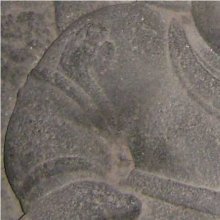Padmanidhi, Padma-nidhi: 7 definitions
Introduction:
Padmanidhi means something in Hinduism, Sanskrit, the history of ancient India. If you want to know the exact meaning, history, etymology or English translation of this term then check out the descriptions on this page. Add your comment or reference to a book if you want to contribute to this summary article.
Images (photo gallery)
In Hinduism
Shilpashastra (iconography)
Source: Archaeological Survey of India: Śaiva monuments at Paṭṭadakal (śilpa)Padmanidhi (पद्मनिधि) is a sculpture found at the temple of Lokeśvara.—The main shrine starts from the eastern wall to which abut the kakṣāsanas. On both side walls there are man-size seated images of Śaṅkhanidhi and Padmanidhi. They are representatives of two treasures of Kubera, the god of wealth. They are carved in man size. Both are shown plump, because it is believed that they are a sign of opulence. Both are bedecked with various ornaments and headdress. Śaṅkhanidhi, as his name suggests, holds a conch in his hand, whereas Padmanidhi holds a padma, a lotus. Below and on the side of the southern one, Padmanidhi, are again engraved inscriptions in Kannaḍa script and language.
Another sculpture is found as part of the Sūrya (sun god) sculpture, at the eastern porch ceiling.—In the upper portion of the tableau, by the side of the Sun are two makara, aquatic animals from the mouth of which are jutting out two human beings. Below these personages are seated two devotees, one on each side. They are Daṇḍin and Piṅgala. The former with a palm leaf book and a style is writing. On the snouts of aquatic reptiles are seated Śaṅkhanidhi and Padmanidhi. On the right hand side of the tableau, Mandeha, a group of demons who tried to attack the sun god, are taking to their heels. It is believed that they were taken aback when seven ascetics began to offer morning arghya, offering water respectfully to Sūrya. So these ascetics are shown on the right side of the god and on the left side are seen celestial beings offering flowers to him.

Shilpashastra (शिल्पशास्त्र, śilpaśāstra) represents the ancient Indian science (shastra) of creative arts (shilpa) such as sculpture, iconography and painting. Closely related to Vastushastra (architecture), they often share the same literature.
Shaktism (Shakta philosophy)
Source: Brill: Śaivism and the Tantric Traditions (shaktism)Padmanidhi (पद्मनिधि) is the name of a deity, according to the King Vatsarāja’s Pūjāstuti called the Kāmasiddhistuti (also Vāmakeśvarīstuti), guiding one through the worship of the Goddess Nityā.—Accordingly, “[...] I worship the three-eyed sharp-natured Kṣetreśa. His body is black, he has destroyed his adversaries, he carries a skull-bowl and a spear, [but] he is compassionate. I resort to Śaṅkhanidhi and Padmanidhi, who who sit upon a conch and lotus [respectively] as their seats. They are patient, bear the gestures of generosity and protection in their hands, and bring about everyone’s dreams. [...]

Shakta (शाक्त, śākta) or Shaktism (śāktism) represents a tradition of Hinduism where the Goddess (Devi) is revered and worshipped. Shakta literature includes a range of scriptures, including various Agamas and Tantras, although its roots may be traced back to the Vedas.
General definition (in Hinduism)
Source: archive.org: South Indian Festivities (hinduism)Padmanidhi (पद्मनिधि) or simply padma, refers to one of the eight nidhis that are under the control of Devi (the Goddess).—The nidhi called Padma is said to be presidedover by Lakshmi and people attaining this nidhi secure prowess and skill in warfare and also command the wealth of all mortals. The two nidhis Sanka and Padma confer on individuals mundane enjoyments and heavenly bliss. The wealth secured by Padma-nidhi makes worldly enjoyments possible and the yogic powers conferred by Sanka-nidhi result in bliss arising from self-realisation. As these two nidhis control in fact the other Nidhis, sculptural representations of these two nidhis only are placed at the sides of temple entrances in southern India.
India history and geography
Source: Cologne Digital Sanskrit Dictionaries: Indian Epigraphical GlossaryPadma-nidhi.—(IE 8-8), a sacred deposit made in the temple treasury. Cf. the coin called padmanidhi-malla-māḍa which was probably issued by the temples. Note: padma-nidhi is defined in the “Indian epigraphical glossary” as it can be found on ancient inscriptions commonly written in Sanskrit, Prakrit or Dravidian languages.

The history of India traces the identification of countries, villages, towns and other regions of India, as well as mythology, zoology, royal dynasties, rulers, tribes, local festivities and traditions and regional languages. Ancient India enjoyed religious freedom and encourages the path of Dharma, a concept common to Buddhism, Hinduism, and Jainism.
Languages of India and abroad
Sanskrit dictionary
Source: DDSA: The practical Sanskrit-English dictionaryPadmanidhi (पद्मनिधि).—a treasure of the value of a Padma.
Derivable forms: padmanidhiḥ (पद्मनिधिः).
Padmanidhi is a Sanskrit compound consisting of the terms padma and nidhi (निधि).
Source: Cologne Digital Sanskrit Dictionaries: Monier-Williams Sanskrit-English DictionaryPadmanidhi (पद्मनिधि):—[=padma-nidhi] [from padma] m. Name of one of the 9 treasures of Kubera (also personified), [Pañcatantra]
[Sanskrit to German]
Sanskrit, also spelled संस्कृतम् (saṃskṛtam), is an ancient language of India commonly seen as the grandmother of the Indo-European language family (even English!). Closely allied with Prakrit and Pali, Sanskrit is more exhaustive in both grammar and terms and has the most extensive collection of literature in the world, greatly surpassing its sister-languages Greek and Latin.
See also (Relevant definitions)
Partial matches: Padma, Nidhi, Niti.
Starts with: Padmanidhi-malla-mada.
Ends with: Mahapadmanidhi.
Full-text (+14): Shankhanidhi, Padmanidhi-malla-mada, Shankanidhi, Padma, Trikshana, Tikshna, Bibhrana, Vishvasamkalpa, Kapala, Ikshana, Kshata, Abhayadhara, Shankhasana, Varabhaya, Vara, Shula, Samkalpa, Krishna, Padmasana, Kalpaka.
Relevant text
Search found 10 books and stories containing Padmanidhi, Padma-nidhi; (plurals include: Padmanidhis, nidhis). You can also click to the full overview containing English textual excerpts. Below are direct links for the most relevant articles:
The Garuda Purana (by Manmatha Nath Dutt)
Chapter LIII - Traits of conduct of men marked by the several kinds of Nidhis < [Agastya Samhita]
Chapter XXXIV - Hayagriva worship < [Agastya Samhita]
The Skanda Purana (by G. V. Tagare)
Chapter 25 - The Construction and Installation of the Chariot of the Lord < [Section 2 - Puruṣottama-kṣetra-māhātmya]
Chapter 24 - Devas Eulogize the Lord: Padmanidhi’s Reception < [Section 2 - Puruṣottama-kṣetra-māhātmya]
Chapter 26 - Indradyumna Worships the Lord: King Gāla Submits to Indradyunma < [Section 2 - Puruṣottama-kṣetra-māhātmya]
Tiruvaymoli (Thiruvaimozhi): English translation (by S. Satyamurthi Ayyangar)
Pasuram 4.10.7 < [Section 10 - Tenth Tiruvaymoli (Onrum-tevum, ulakum)]
Puranic encyclopaedia (by Vettam Mani)
Bhajana-Rahasya (by Srila Bhaktivinoda Thakura Mahasaya)
Text 8 < [Chapter 5 - Pañcama-yāma-sādhana (Aparāhna-kālīya-bhajana–kṛṣṇa-āsakti)]
Pallava period (Social and Cultural History) (by S. Krishnamurthy)
Vaikakshaka or Chhannavira < [Chapter 4 - Material Culture of the People]
Armlets (Keyuras) < [Chapter 4 - Material Culture of the People]
Yajnopavita (Sacrificial Thread) < [Chapter 4 - Material Culture of the People]

